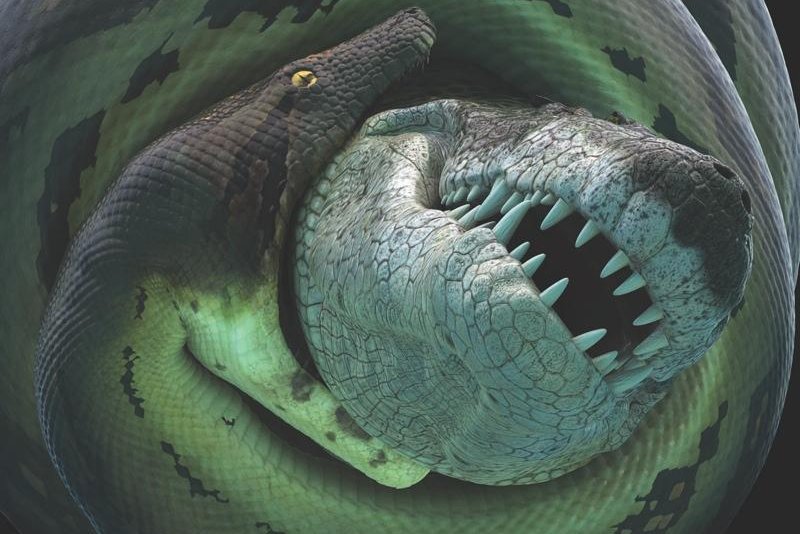The ancient croc Balrog tussles with his rival Titanoboa, the monster snake of the ancient rainforest. (University of Florida)
CERREJON, Colombia, June 4 (UPI) -- Even Happy Gilmore wouldn't stand a chance against Balrog, the ancient croc named for the Mines of Moria monster in Tolkien's Lord of the Rings. Perhaps no one would stand a chance against the ancient 16-foot, 900-pound croc, whose remains were discovered in an open-pit coal mine -- one of the world's largest -- in Cerrejon, Colombia.
Balrog -- or more scientifically, Anthracosuchus balrogus -- may have one worthy opponent. The massive crocodile was excavated from the same layer of rock that preserved Titanoboa, a fearsome ancient snake that stretched some 58 feet in length.
Some 60 million years ago, both Balrog and Titanoboa shared the waters of the ancient rivers that snaked through the world's oldest-known rain forest.
Balrog is an entirely new species of croc, one of the world's oldest.
"It quickly became clear that the four fossil specimens were unlike any dyrosaur species ever found," said Alex Hastings, who helped lead the expedition into the Colombian mine and authored the subsequent paper on the Balrog's discovery -- recently published in the journal Historical Biographies.
Hastings is now a postdoctoral researcher at Martin Luther University of Halle-Wittenberg in Germany but was working as a graduate biology student at the Florida Museum of Natural History when Balrog was unearthed.
Hastings says Balrog's snout is much shorter and stouter than today's crocodiles and alligators, modern descendants of dyrosaurs.
"Everyone thinks that crocodiles are living fossils that have remained virtually unchanged for the last 250 million year," Hastings added. "But what we're finding in the fossil record tells a very different story."
Balrog is helping to prove otherwise, as are other species of dyrosaurs being uncovered in the Columbian mine. Crocodiles were already quite genetically diversified as early as 60 million years ago, scientists say.
Balrog literally stunned the scientists who studied his ancient bones.
"We couldn't believe it had such a boxy, short skull and that it was still a dyrosaur," said Jonathan Bloch, co-author of the new study. Bloch serves as the Florida Museum associate curator of vertebrate paleontology.
"It really busts the mold for these animals. It is such a completely different looking beast than we've seen for these crocodile-like animals."















